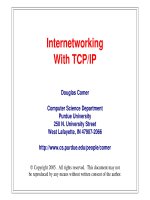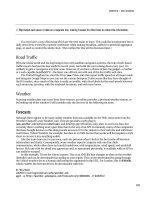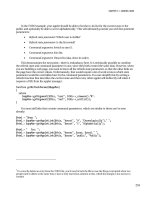Internetworking with TCP/IP- P37 pps
Bạn đang xem bản rút gọn của tài liệu. Xem và tải ngay bản đầy đủ của tài liệu tại đây (511.47 KB, 10 trang )
Internet Multicasting
17.1 Introduction
Earlier chapters define the original
IP
classful addressing scheme and extensions
such as subnetting and classless addressing. This chapter explores an additional feature
of the
IP
addressing scheme that permits efficient multipoint delivery of datagram. We
begin with a brief review of the underlying hardware support. Later sections describe
IP
addressing for multipoint delivery and protocols that routers use to propagate the
necessary routing information.
17.2 ~Qrdware Broadcast
I
Many hardware technologies contain mechanisms to send packets to multiple desti-
nations $multaneously (or nearly simultaneously). Chapter
2
reviews several technolo-
gies
9
discusses the most common form of multipoint delivery:
broadcasting.
Broad-
cast delivery means that the network delivers one copy of a packet to each destination.
On bus technologies like Ethernet, broadcast delivery can
be
accomplished with a single
packet transmission.
On
networks composed of switches with point-to-point comec-
tions, software must implement broadcasting by forwarding copies of the packet across
individual connections until all switches have received a copy.
With most hardware technologies, a computer specifies broadcast delivery by send-
ing a packet to a special, reserved destination address called the
broadcast address.
For
example, Ethernet hardware addresses consist of 48-bit identifiers, with the all 1s ad-
dress used to denote broadcast. Hardware on each machine recognizes the machine's
hardware address as well
as
the broadcast address, and accepts incoming packets that
have either address as their destination.
320
Internet Multicasting
Chap.
17
The chief disadvantage of broadcasting arises from its demand on resources
-
in
addition to using network bandwidth, each broadcast consumes computational resources
on all machines. For example, it would
be
possible to design
an
alternative internet
protocol suite that used broadcast to deliver datagrams on a local network and relied on
IP
software to discard datagrams not intended for the local machine. However, such a
scheme would be extremely inefficient because all computers on the network would re-
ceive and process every datagram, even though a machine would discard most of the
datagrams that arrived. Thus, the designers of
TCPIIP used unicast routing and address
binding mechanisms like
ARP
to eliminate broadcast delivery.
17.3
Hardware Origins Of Multicast
Some hardware technologies support a second, less common form of multi-point
delivery called
multicasting.
Unlike broadcasting, multicasting allows each system to
choose whether it wants to participate in a given multicast. Typically, a hardware tech-
nology reserves a large set of addresses for use with multicast. When a group of
machines want to communicate, they choose one particular
multicast address
to use for
communication. After configuring their network interface hardware to recognize the
selected multicast address, all machines in the group will receive a copy of any packet
sent to that multicast address.
At a conceptual level, multicast addressing can be viewed as a generalization of all
other address forms. For example, we can think of a conventional
unicast address
as a
form of multicast addressing in which there is exactly one computer in the multicast
group. Similarly, we can think of directed broadcast addressing as a form of multicast-
ing in which all computers on a particular network are members of the multicast group.
Other multicast addresses can correspond to arbitrary sets of machines.
Despite its apparent generality, multicasting cannot replace conventional forms be-
cause there is a fundamental difference in the underlying mechanisms that implement
forwarding and delivery. Unicast and broadcast addresses identify a computer or a set
of computers attached to one physical segment, so forwarding depends on the network
topology. A multicast address identifies an arbitrary set of listeners, so the forwarding
mechanism must propagate the packet to all segments. For example, consider two
LAN
segments connected by an adaptive bridge that has learned host addresses. If a host on
segment
1
sends a unicast frame to another host on segment
1,
the bridge will not for-
ward the frame to segment
2.
If a host uses a multicast address, however, the bridge
will forward the frame. Thus. we can conclude:
Although it may help us to think of multicast addressing as a generali-
zation that subsumes unicast and broadcast addresses, the underlying
forwarding and delivery mechanisms can make multicast less eficient.
Sec.
17.3
Hardware Origins
Of
Multicast
321
17.4 Ethernet Multicast
Ethernet provides a good example of hardware multicasting. One-half of the Eth-
ernet addresses
are
reserved for multicast
-
the low-order bit of the high-order octet
distinguishes conventional unicast addresses
(0)
from multicast addresses
(I).
In
dotted
hexadecimal notation?, the multicast bit is given by:
When an Ethernet interface board is initialized, it begins accepting packets destined
for either the computer's hardware address or the Ethernet broadcast address. However,
device driver software can
reconfigure the device to allow it to also recognize one or
more multicast addresses. For example, suppose the driver configures the Ethernet mul-
ticast address:
After the configuration, an interface will accept any packet sent to the computer's
uni-
cast address, the broadcast address, or that one multicast address (the hardware will con-
tinue to ignore packets sent to other multicast addresses). The next sections explain
both how
IP
uses basic multicast hardware and the special meaning of the multicast ad-
dress
17.5 IP Multicast
IP
multicasting
is the internet abstraction of hardware multicasting. It follows the
paradigm of allowing transmission to a subset of host computers, but generalizes the
concept to allow the subset to spread across arbitrary physical networks throughout the
internet.
In
IP
terminology, a given subset is known as a
multicast group.
IP
multicast-
ing has the following general characteristics:
Group address.
Each multicast group is a unique class
D
address.
A
few
IP
multicast addresses are permanently assigned by the Internet authority, and
correspond to groups that always exist even
if
they have no current members.
Other addresses are temporary, and are available for private use.
Number of groups.
IP
provides addresses for up to
228
simultaneous multicast
groups. Thus, the number of groups is limited by practical constraints on rout-
ing table size rather than addressing.
Dynamic group membership.
A
host can join or leave an
IP
multicast group at
any time. Furthermore, a host may be a member of
an
arbitrary number of
multicast groups.
?Dotted hexadecimal notation represents each
octet
as two hexadecimal digits with octets separated by
periods; the subscript
16
can
be
omitted only when the context is unambiguous.
322
Internet
Multicasting
Chap.
17
Use of hardware.
If the underlying network hardware supports multicast,
IF'
uses hardware multicast to send
IP
multicast.
If
the hardware does not support
multicast,
IF'
uses broadcast or unicast to deliver
IP
multicast.
Inter-network forwarding.
Because members of an
IF'
multicast group can at-
tach to multiple physical networks, special
multicast routers
are required to for-
ward
IF'
multicast; the capability is usually added to conventional routers.
Delivery semantics.
IF'
multicast uses the same best-effort delivery semantics
as
other IP datagram delivery, meaning that multicast datagrams can be lost, de-
layed, duplicated, or delivered out of order.
Membership and transmission.
An
arbitrary host may send datagrams to any
multicast group; group membership is only used to determine whether the host
receives datagram sent to the group.
17.6
The
Conceptual
Pieces
Three conceptual pieces are required for a general purpose internet multicasting
system:
1.
A multicast addressing scheme
2.
An
effective notification and delivery mechanism
3.
An
efficient internetwork forwarding facility
Many goals, details, and constraints present challenges for an overall design. For
example, in addition to providing sufficient addresses for many groups, the multicast
addressing scheme
must accommodate two conflicting goals: allow local autonomy in
assigning addresses, while defining addresses that have meaning globally. Similarly,
hosts need a
notification mechanism
to inform routers about multicast groups in which
they
are
participating, and routers need a
delivery mechanism
to transfer multicast pack-
ets to hosts. Again there are two possibilities: we desire a system that makes effective
use of hardware multicast when it is available, but also allows
IF'
multicast delivery
over networks that do not have hardware support for multicast. Finally a multicast
for-
warding facility
presents the biggest design challenge of the
three:
our goal is a scheme
that is both efficient and dynamic
-
it should route multicast packets along the shortest
paths, should not send a copy of a datagram along a path if the path does not lead to a
member of the group, and should allow hosts to join and leave groups at any time.
IF'
multicasting includes all
three
aspects. It defines
IP
multicast addressing, speci-
fies how hosts send and receive multicast datagrams, and describes the protocol routers
use to determine multicast group membership on a network. The remainder of the
chapter considers each aspect in more detail, beginning with addressing.
Sec.
17.7
IP
Multicast
Addresses
323
1
7.7
IP
Multicast Addresses
We said that
IP
multicast addresses are divided into two types: those that are per-
manently assigned, and those that are available for temporary use. Permanent addresses
are called well-known; they are used for major services on the global Internet as well as
for infrastructure maintenance
(e.g., multicast routing protocols). Other multicast ad-
dresses correspond to transient multicast groups that are created when needed and dis-
carded when the count of group members reaches zero.
Like hardware multicasting,
IP
multicasting uses the datagram's destination ad-
dress to specify that a particular datagram must be delivered via multicast.
IP
reserves
class
D
addresses for multicast; they have the form shown
in
Figure 17.1.
Figure
17.1
The format of class D
IP
addresses used for multicasting. Bits
4
through
31
identify
a
particular multicast group.
01234
31
The first
4
bits contain
1110
and identify the address as a multicast. The remain-
ing
28
bits specify a particular multicast group. There is no further structure in the
group bits.
In
particular, the group field is not partitioned into bits that identify the ori-
gin or owner of the group, nor does it contain administrative information such as wheth-
er all members of the group are on one physical network.
When expressed
in
dotted decimal notation, multicast addresses range from
1110
224.0.0.0 through 239.255.255.255
Group Identification
However, many parts of the address space have been assigned special meaning. For ex-
ample, the lowest address, 224.0.0.0, is reserved; it cannot be assigned to any group.
Furthemlore, the remaining addresses up through 224.0.0.255 are devoted to multicast
routing and group maintenance protocols; a router is prohibited from forwarding a da-
tagram sent to any address in that range. Figure 17.2 shows a few examples of per-
manently assigned addresses.
Internet
Multicasting
Chap.
17
224.0.0.0
224.0.0.1
224.0.0.2
224.0.0.3
224.0.0.4
224.0.0.5
224.0.0.6
224.0.0.7
224.0.0.8
224.0.0.9
224.0.0.1 0
224.0.0.1 1
224.0.0.1 2
224.0.0.1 3
224.0.0.1 4
224.0.0.1 5
224.0.0.1 6
224.0.0.1 7
224.0.0.1 8
224.0.0.1 9
through
224.0.0.255
224.0.1.21
224.0.1.84
224.0.1.85
239.1 92.0.0
through
239.251.255.255
239.252.0.0
through
239.255.255.255
Address Meaning
Base Address (Reserved)
All Systems on this
Subnet
All Routers on this Subnet
Unassigned
DVMRP Routers
OSPFIGP All Routers
OSPFIGP Designated Routers
ST Routers
ST Hosts
RIP2 Routers
IGRP Routers
Mobile-Agents
DHCP Server
/
Relay Agent
All PIM Routers
RSVP-Encapsulation
All-CBT-Routers
Designated-Sbm
All-Sbms
VRRP
Unassigned
DVMRP on MOSPF
Jini Announcement
Jini Request
Scope restricted to one organization
Scope restricted to one site
Figure
17.2
Examples of
a
few permanent
IP
multicast address assignments.
Many other addresses have specific meanings.
We will see that two of the addresses in the figure are especially important to the
multicast delivery mechanism. Address 224.0.0.1 is permanently assigned to the
all
systems group,
and address 224.0.0.2 is permanently assigned to the
all
routers group.
The
all
systems
group includes all hosts and routers on a network that are participating
in
IP
multicast, whereas the
all
routers
group includes only the routers that are partici-
pating.
In
general, both of these groups are used for control protocols and not for the
Sec. 17.7
IP
Multicast
Addresses
325
normal delivery of data. Furthermore, datagrams sent to these addresses only reach
machines on the same local network as the sender; there are no
IP
multicast addresses
that refer to all systems in the internet or all routers in the internet.
17.8 Multicast Address Semantics
IP
treats multicast addresses differently than unicast addresses. For example, a
multicast address can only be used as a destination address. Thus, a multicast address
can never appear in the source address field of a datagram, nor can it appear in a source
route or record route option. Furthermore, no
ICMP
error messages can be generated
about multicast datagrams (e.g., destination unreachable, source quench, echo reply, or
time exceeded). Thus, a ping sent to a multicast address will go unanswered.
The rule prohibiting
ICMP
errors is somewhat surprising because
IP
routers do
honor the time-to-live field in the header of a multicast datagram. As usual, each router
decrements the count, and discards the datagram (without sending an
ICMP
message) if
the count reaches zero. We will see that some protocols use the time-to-live count as a
way to limit datagram propagation.
17.9 Mapping IP Multicast
To
Ethernet Multicast
Although the
IP
multicast standard does not cover all types of network hardware, it
does specify how to map an
IP
multicast address to an Ethernet multicast address. The
mapping is efficient and easy to understand:
To map an IP multicast address to the corresponding Ethernet multi-
cast address, place the low-order 23 bits of the IP multicast address
into the low-order 23 bits of the special Ethernet multicast address
01.00.5E.00.00.00,,
For example,
IP
multicast address 224.0.0.2 becomes Ethernet multicast address
01.00.5E.00.00.02,,.
Interestingly, the mapping is not unique. Because
IP
multicast addresses have 28
significant bits that identify the multicast group, more than one multicast group may
map onto the same Ethernet multicast address at the same time. The designers chose
this scheme as a compromise.
On
one hand, using 23 of the 28 bits for a hardware ad-
dress means most of the multicast address is included. The set of addresses is large
enough so the chances of two groups choosing addresses with all low-order 23 bits
identical is small. On the other hand, arranging for
IP
to use a fmed part of the Ether-
net multicast address space makes debugging much easier and eliminates interference
between
IP
and other protocols that share an Ethernet. The consequence of this design
is that some multicast datagrams may
be
received at a host that are not destined for that
host. Thus, the
IP
software must carefully check addresses on all incoming datagrams
and discard any unwanted multicast datagrams.
Internet Multicasting
Chap.
17
17.10
Hosts
And
Multicast Delivery
We said that
IP
multicasting can be used on a single physical network or
throughout an internet. In the former case, a host can send directly to a destination host
merely by placing the datagram in a frame and using a hardware multicast address to
which the receiver is listening. In the latter case, special
multicast routers
forward mul-
ticast datagrams among networks, so a host must send the datagram to a multicast
router. Surprisingly, a host does not need to install a route to a multicast router, nor
does the host's default route need to specify one. Instead, the technique a host uses to
forward a multicast datagram to a router is unlike the routing lookup used for unicast
and broadcast datagrams
-
the host merely uses the local network hardware's multicast
capability to transmit the datagram. Multicast routers listen for all
IP
multicast
transmissions; if a multicast router is present on the network, it will receive the da-
tagram and forward it on to another network if necessary. Thus, the primary difference
between local and nonlocal multicast lies in multicast routers, not in hosts.
17.1
1
Multicast
Scope
The
scope
of a multicast group refers to the range of group members.
If
all
members are on the same physical network, we say that the group's scope is restricted
to one network. Similarly, if
all
members of a group lie within a single organization,
we say that the group has a scope limited to one organization.
In addition to the group's scope, each multicast datagram has a scope which is de-
fined to
be
the set of networks over which a given multicast datagram will be propagat-
ed. Informally, a datagram's scope is referred to
as
its
range.
IP
uses two techniques to control multicast scope. The first technique relies on the
datagram's
time-to-live
(mL)
field to control its range.
By
setting the TTL to a small
value, a host can limit the distance the datagram will be routed. For example, the stan-
dard specifies that control messages, which are used for communication between a host
and a router on the same network, must have a
TTL
of
1.
As a consequence, a router
never forwards any datagram carrying control information because the
TTL
expires
causing the router to discard the datagram. Similarly,
if
two applications mnning on a
single host want to use
IP
multicast for interprocessor communication (e.g., for testing
software), they can choose a
TTL
value of
0
to prevent the datagram from leaving the
host. It is possible to use successively larger values of the
TTL
field to further extend
the notion of scope. For example, some router vendors suggest configuring routers at a
site to restrict multicast datagrams from leaving the site unless the datagram has a TTL
greater than
15.
We conclude that it is possible to use the
'ITL
field
in
a datagram
header to provide coarse-grain control over the datagram's scope.
Known as
administrative scoping,
the second technique used to control scoping
consists of reserving parts of the address space for groups that
are
local to a given site
or local to a given organization. According to the standard, routers in the Internet
are
forbidden from forwarding any datagram that has an address chosen from the restricted
Sec.
17.1 1
Multicast
Scope
327
space. Thus, to prevent multicast communication among group members from acciden-
tally reaching outsiders, an organization can assign the group an address that has local
scope. Figure 17.2 shows examples of address ranges that correspond to administrative
scoping.
17.12
Extending Host Software
To
Handle Multicasting
A
host participates in
IP
multicast at one of three levels as Figure 17.3 shows:
Level Meaning
0
Host can neither send nor receive IP multicast
1
Host can send but not receive IP multicast
2
Host can both send and receive IP multicast
Figure
17.3
The
three
levels
of
participation in
IP
multicast.
Modifications that allow a host to send
IP
multicast are not difficult. The
IP
software must allow an application program to specify a multicast address
as
a destina-
tion
IP address, and the network interface software must be able to map an
IF'
multicast
address into the corresponding hardware multicast address (or use broadcast
if
the
hardware does not support multicasting).
Extending host software to receive
IP
multicast datagrams is more complex.
IP
software on the host must have an API that allows
an
application program to declare
that it wants to join or leave a particular multicast group.
If multiple application pro-
grams join the same group, the
IP
software must remember to pass each of them a copy
of datagrams that arrive destined for that group. If all application programs leave a
group, the host must remember that it no longer participates in the group. Furthermore,
as we will see in the next section, the host must
run
a protocol that informs the local
multicast routers of its group membership status. Much of the complexity comes from
a basic idea:
Hosts join specijk
IP
multicast groups on specific networks.
That is, a host with multiple network connections may join a particular multicast group
on one network and not on another. To understand the reason for keeping group
membership associated with networks, remember that it is possible to use
IP
multicast-
ing among local sets of machines. The host may want to use a multicast application to
interact with machines on one physical net, but not with machines on another.
Because group membership is associated with particular networks, the software
must keep separate lists of multicast addresses for each network to which the machine
attaches. Furthermore, an application program must specify a particular network when
it asks to join or leave a multicast group.
328
Internet Multicasting Chap.
17
17.1
3
Internet Group Management Protocol
To participate in
IP
multicast on a local network, a host must have software that al-
lows it to send and receive multicast datagrams. To participate in a multicast that spans
multiple networks, the host must inform local multicast routers. The local routers con-
tact other multicast routers, passing on the membership information and establishing
routes. We will see later that the concept is similar to conventional route propagation
among internet routers.
Before a multicast router can propagate multicast membership information, it must
determine that one or more hosts on the local network have decided to join a multicast
group. To do so, multicast routers and hosts that implement multicast must use the
In-
ternet Group Management Protocol (IGMP)
to communicate group membership infor-
mation. Because the current version is
2,
the protocol described here is officially
known as
IGMPv2.
IGMP is analogous to ICMP?. Like ICMP, it uses
IP
datagrams to carry mes-
sages. Also like ICMP, it provides a service used by
IP.
Therefore,
Although IGMP uses IP datagrams to carry messages, we think of it
as
an
integral part of ZP, not
a
separate protocol.
Furthermore, IGMP is a standard for TCPA'; it is required on
all
machines that receive
IP
multicast (i.e., all hosts and routers that participate at level
2).
Conceptually, IGMP has two phases. Phase
1:
When a host joins a new multicast
group, it sends an IGMP message to the group's multicast address declaring its
membership.
Local
multicast routers receive the message, and establish necessary rout-
ing by propagating the group membership information to other multicast routers
throughout the internet. Phase
2:
Because membership is dynamic, local multicast
routers periodically
poll
hosts on the local network to determine whether any hosts still
remain members of each group. If any host responds for a given group, the router
keeps the group active.
If
no host reports membership in a group after several polls, the
multicast router assumes that none of the hosts on the network remain
in
the group, and
stops advertising group membership to other multicast routers.
17.14 IGMP Implementation
IGMP is carefully designed to avoid adding overhead that can congest networks.
In particular, because a given network can include multiple multicast routers as well as
hosts that all participate in multicasting, IGMP must avoid having all participants gen-
erate control traffic. There are several ways IGMP minimizes its effect on the network:
First, all communication between hosts and multicast routers uses
IP
multi-
cast. That is, when IGMP messages are encapsulated
in
an
IP
datagram for
transmission, the
IP
destination address is a multicast address
-
routers
tChapter 9 discusses
ICMP,
the Internet Control Message Protocol.









